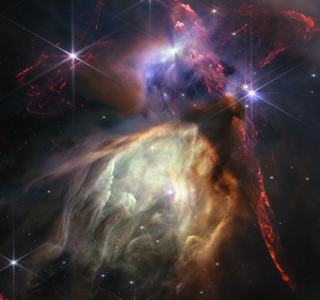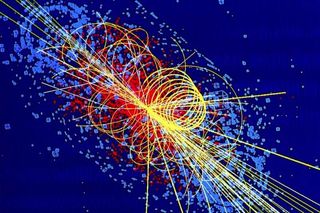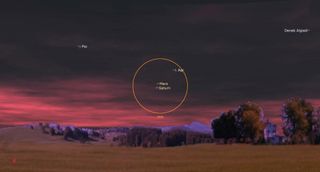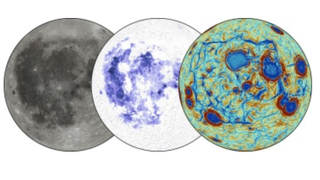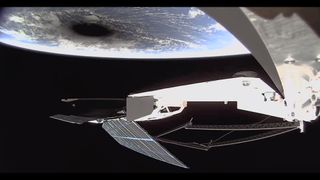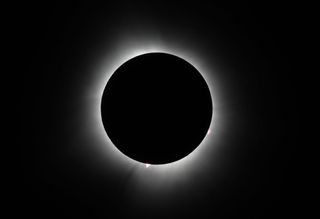Every new parent knows the cold anxiety that grips them when their baby sneezes for the first time. That’s when a litany of possible issues and ailments probably begin to irrationally race through your mind. Researchers now know baby stars also “sneeze,” but these infinitely more powerful post-natal sneezes launch gas, dust, and magnetic energy. In other words, they’re more useful to the cosmos than stressful. These eruptions from so-called “protostars” are actually a vital part of stellar development, and can tell scientists a great deal about that stellar body’s evolution…
Read MoreCategory: Solar System
Our solar system
A NASA spacecraft spotted something weird orbiting the moon. It was just a lunar neighbor (photos)
NASA’s Lunar Reconnaissance Orbiter (LRO) snapped a perfectly timed photo as it crossed paths with another spacecraft orbiting the moon. The LRO, which has been orbiting the moon for 15 years, captured several images of the Korea Aerospace Research Institute’s Danuri lunar orbiter as the two spacecraft, traveling in nearly parallel orbits, zoomed past each other in opposite directions during three orbits between March 5 and March 6, according to a statement from NASA. Danuri, the Republic of Korea’s first moon-explorer, has been in lunar orbit since December 2022. At…
Read MoreWhy Peter Higgs leaves a massive legacy in the field of physics
On April 8, 2024, British theoretical physicist Peter Ware Higgs passed away at the age of 94. It was almost 12 years ago, on July 4, 2012, in a fairly inauspicious lecture hall located in Geneva, Switzerland, when Higgs became an iconic figure in modern science. That was the day it was announced that collisions between particles at the Large Hadron Collider (LHC) facility — arguably the most ambitious and audacious science experiment ever — revealed the existence of the Higgs Boson. The discovery of the Higgs boson, named for…
Read MoreSee Jupiter close to a crescent moon (Mars near Saturn, too) in the ‘View a Planet Day’ night sky
In an unofficial sense, I would like to dub today (April 10) as “View a Planet Day.” In the early morning hours will be two planets that will appear very close to each other and then later that same day, in the early evening sky we’ll have a chance to see Jupiter hovering near to a slender waxing crescent moon, making for a rather eye-catching sight. And there will be other celestial objects out there to see and find as well among the brightest planets in the night sky. Here…
Read MoreWhat happened when the moon ‘turned itself inside out’ billions of years ago?
Over 4.2 billion years ago, the moon turned itself inside out to create the lunar surface that has become familiar to humanity. Most scientists would agree the moon was created around 4.5 billion years ago, when another massive body in the solar system smashed into Earth, flinging molten material into space that coalesced as our natural satellite. How the birth of the moon proceeded after this violent start, however, has been described as “more of a choose-your-own-adventure novel” by a team of scientists from the University of Arizona’s Lunar and…
Read MoreSatellite views of solar eclipse 2024: See the moon’s shadow race across North America (video, photos)
Satellites saw the moon’s shadow from space on Monday (April 8). The 2024 total solar eclipse was visible in parts of the United States, Canada and Mexico on that day, thrilling millions of spectators across North America — and from space, satellites could see the shadow of the moon falling across those regions in real-time. The National Oceanic and Atmospheric Administration (NOAA) showcased the resulting photos, taken with the organization’s Geostationary Operational Environmental Satellites (GOES) series. For example, the imager on the GOES-16 satellite tracked the moon’s shadow using its…
Read MoreThese solar eclipse 2024 photos from our readers are absolutely amazing (images, video)
On Monday, April 8, a total solar eclipse swept through the skies over North America, delighting and astounding millions of onlookers who had traveled from across the globe to take in this incredible event. And our own space readers got in on the act, too. The sun was completely obscured by the moon across what is known as the “path of totality,” which was approximately 115 miles (185 kilometers) wide and 10,000 miles long (16,000 kilometers). This 2024 total solar eclipse path crossed the four Mexican states of Sinaloa, Nayarit,…
Read MoreI proposed to my fiancée under the diamond ring of the 2024 total solar eclipse. (She said ‘Yes!’)
BLOOMINGTON, Ind. — I worked out the perfect plan to propose to my partner during the April 8 solar eclipse, and the clouds somehow stayed away. I won’t bury the lede. She said yes. I spent the last year planning my proposal to coincide with the 2024 total solar eclipse, lining up the perfect photo, figuring out what I would say, and getting the timing just right. I couldn’t be happier with how the day went. I’m not sure when it dawned on me, but with totality passing directly over my…
Read MoreTotal solar eclipse 2024 thrills millions across North America (video, photos)
The moon turned daytime skies dark as it swept across North America in a total solar eclipse Monday (April 8), thrilling tens of millions of skywatchers who had their eyes glued to the skies. All of North America and Central America experienced a partial solar eclipse, but only those located within the path of totality — an approximately 115-mile (185-kilometer) wide and 10,000-mile-long (16,000 kilometers) route — saw the moon completely obscure the sun. Related: Total solar eclipse 2024: Pictures from around the web Image 1 of 3 Thhe sun…
Read MoreTotal solar eclipse 2024 has begun and here are the first views!
It’s the moment eclipse-chasers have been waiting for. This year’s first solar eclipse has begun! The total solar eclipse first made landfall in North America at Mazatlán in Sinaloa, Mexico, with the moon beginning to take its first “bite” out of the sun at 9:51 a.m. local time (12:51 p.m. EDT, 1651 GMT). Totality will begin in Sinaloa about one hour and 16 minutes later at 11:07 a.m. local time (2:07 p.m. EDT, 1807 GMT). You can watch the total solar eclipse live here on Space.com. And keep up with…
Read More